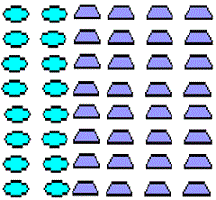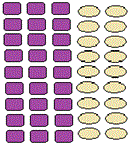Solved Examples and Worksheet for Distributive Property of Multiplication over Addition
A. (7 × 5) + (7 × 2)
B. (7 × 50) + (7 × 2)
C. 5 × 72
D. (7 × 49) - (7 × 3)
Step: 1
7 × 52
[Original expression.]
Step: 2
= 7 × (50 + 2)
[Rewrite 52 as sum of 50 and 2.]
Step: 3
= 7 × 50 + 7 × 2
[a b c a b a c
Step: 4
Therefore, (7 × 50) + (7 × 2) is equivalent to 7 × 52.
Correct Answer is : (7 × 50) + (7 × 2)
A. (3 × 31) + (3 × 1)
B. (3 × 30) + (3 × 1)
C. (3 × 30) - (3 × 1)
D. 3 × 13
Step: 1
3 × 31
[original expression.]
Step: 2
3 × (30 + 1)
[Rewrite 31 as sum of 30 and 1.]
Step: 3
= 3 × 30 + 3 × 1
[a × (b + c) = a × b + a × c by distributive property.]
Step: 4
Therefore, (3 × 30) + (3 × 1) is equivalent to 3 × 31.
Correct Answer is : (3 × 30) + (3 × 1)

A. 48
B. 35
C. 38
D. 40
Step: 1
The number of items in each rectangle is the height times the width.
Step: 2
The items= (8 × 2) + (8 × 4)
[So, instead of doing 2 separate multiplications, use distributive property.]
Step: 3
8 × (2 + 4)
[Take out the common factor.]
Step: 4
8 × 6
[Perform addition.]
Step: 5
= 48
[Muliply.]
Correct Answer is : 48

A. 21
B. 25
C. 20
D. 28
Step: 1
The number of items in each rectangle is the height times the width.
Step: 2
The items= (3 × 5) + (3 × 2)
[So, instead of doing 2 separate multiplications, use distributive property.]
Step: 3
= 3 × (5 + 2)
[Take out the common factor.]
Step: 4
3 × 7
[Perform addition.]
Step: 5
= 21
[Multiply]
Correct Answer is : 21

A. 40
B. 42
C. 45
D. 48
Step: 1
The number of items in each rectangle is the height times the width.
Step: 2
The items= (6 × 2) + (6 × 5)
[So, instead of doing 2 separate multiplications, use distributive property.]
Step: 3
6 × (2 + 5)
[Take out the common factor.]
Step: 4
6 × 7
[Perform addition.]
Step: 5
= 42
[Multiply.]
Correct Answer is : 42

A. 35
B. 48
C. 40
D. 38
Step: 1
The number of items in each rectangle is the height times the width.
Step: 2
The items= (7 × 4) + (7 × 2)
[So, instead of doing 2 separate multiplications, use distributive property.]
Step: 3
7 × (4 +2)
[Take out the common factor.]
Step: 4
= 7 × 6
[Perform addition.]
Step: 5
= 42
[Multiply.]
Correct Answer is : 48

A. 30
B. 40
C. 45
D. 35
Step: 1
The number of items in each rectangle is the height times the width.
Step: 2
The items= (5 × 4) + (5 × 3)
[So, instead of doing 2 separate multiplications, use distributive property.]
Step: 3
= 5 × (4 + 3)
[Take out the common factor.]
Step: 4
= 5 × 7
[Perform addition.]
Step: 5
= 35
[Multiply.]
Correct Answer is : 35

A. 10
B. 18
C. 16
D. 15
Step: 1
The number of items in each rectangle is the height times the width.
Step: 2
The items= (2 × 5) + (2 × 3)
[So, instead of doing 2 separate multiplications, use distributive property.]
Step: 3
= 2 × (5 + 3)
[Take out the common factor.]
Step: 4
= 2 × 8
[Perform addition.]
Step: 5
= 16
[Multiply.]
Correct Answer is : 16

A. 48
B. 38
C. 35
D. 40
Step: 1
The number of items in each rectangle is the height times the width.
Step: 2
The items= (9 × 3) + (9 × 2)
[So, instead of doing 2 separate multiplications, use distributive property.]
Step: 3
= 9 × (3 + 2)
[Take out the common factor.]
Step: 4
= 9 × 5
[Perform addition.]
Step: 5
= 45
[Multiply.]
Correct Answer is : 48
- Multiplication Arrays-Gr 3-Solved Examples
- Multiplying 1-Digit Numbers by 1 Digit-Gr 3-Solved Examples
- Multiplying 2-Digit Numbers by 1-Digit Number-Gr 3-Solved Examples
- Number Sentences involving Multiplication-Gr 3-Solved Examples
- Dividing 2-Digit Numbers by 1-Digit Numbers without Remainders-Gr 3-Solved Examples
- Model Division using Equal Groups-Gr 3-Solved Examples
- Number Sentences involving Division-Gr 3-Solved Examples
- Finding Missing Number using Multiplication or Division-Gr 3-Solved Examples
- Multiplication and Division Facts-Gr 3-Solved Examples
- Exploring Commutative Property of Multiplication-Gr 3-Solved Examples
- Exploring Associative Property of Multiplication-Gr 3-Solved Examples
- Solving Two-step Word Problems-Gr 3-Solved Examples
- Application of Estimating Whole Numbers-Gr 3-Solved Examples
- Arithmetic Patterns Involving Addition and Multiplication-Gr 3-Solved Examples
Related Worksheet
- Distributive Property